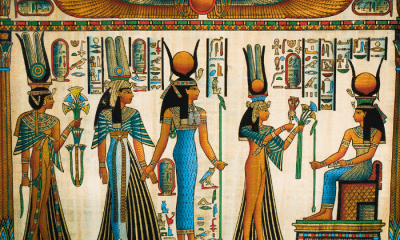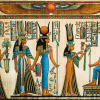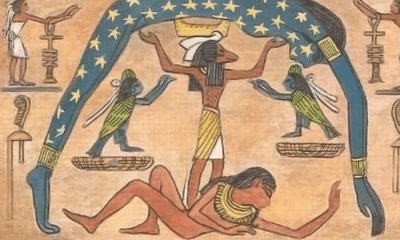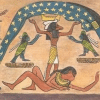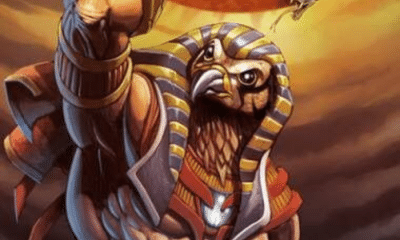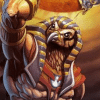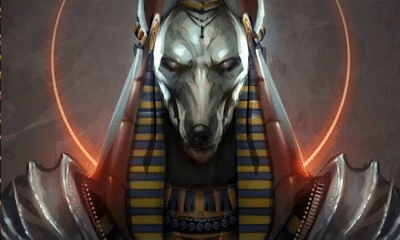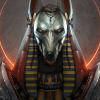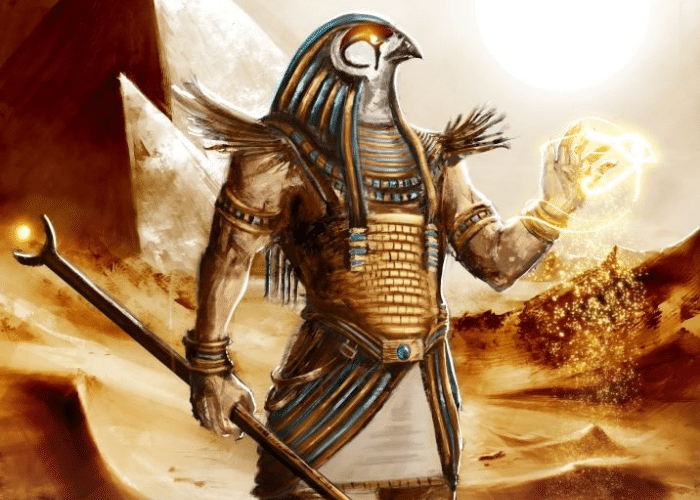
Egyptian
Who Was Horus in Egyptian Mythology?
Who Was Horus in Egyptian Mythology?
The falcon-headed god Horus plays a prominent role in Egyptian mythology. Keep reading to find out who he was and what he stood for!
Falcons are one of the most common motifs in ancient Egyptian art and architecture. They were featured in jewelry, carved on temples, and were included in the hieroglyphics of every Pharaoh’s name.
The birds featured heavily because they were identified with the god Horus. Typically depicted with the head or entire body of a falcon, Horus was a central figure in the Egyptian view of both the universe and earthly power.
As a sky god and the son of Osiris, Horus did more than watch over the sky. His all-seeing eye guarded over both the living and the dead, keeping away the chaotic forces of evil.
Osiris’s son was also the living heir to the god-king’s authority. Winning the crown from his usurper uncle, Horus became the eternal king of both Egypt and the world.
The Earliest Forms of Horus
The cult of Horus was likely one of the earliest in Egypt.
His name is attested from the Predynastic Period, the era before Egypt was unified under a powerful king. Archaeologists have found even older works of art that display a similar form.
Horus was most often shown with the head of a falcon. This is a feature identifiable in art from around Egypt at some of the country’s earliest sites.
Horus’s association with a bird likely began early because he was regarded as a god of the sky.
Egyptian mythology changed significantly over the thousands of years of the country’s ancient civilization. While most modern readers are familiar with the sky goddess Nut, there is evidence that an older tradition imagined the sky as a falcon god.
Some Egyptologists believe that these earlier traditions followed the pattern shown in other cultures of ascribing body parts to the features of the sky. The speckled pattern of a falcon’s wings, for example, could be seen as stars.
As in many other cultures, the sun and moon were believed to be the god’s eyes. Even though Horus did not remain the primary god of the sky, this aspect of his mythology continued for many centuries.
The Heir’s Unusual Birth
According to the most common myth, Horus was the son of Osiris and Isis. His birth, however, was anything but common.
Osiris had been made king by his father, the earth god Geb. He married his sister Isis and ruled his land well.
Their brother Set, however, was eternally jealous of Osiris. He killed his brother and usurped the throne.
By the New Kingdom, a story had become popular that claimed that Set also desecrated Osiris’s corpse. To prevent him from taking his place in the afterlife, Set cut the body to pieces and scattered them throughout Egypt.
Isis and her sister, Nephthys, found and gathered all the pieces. According to one tradition, the only part of Osiris’s body they could not recover was his phallus.
Isis and Nephthys worked together with Anubis and Thoth to reassemble and protect her husband’s body. She fashioned a new male organ to make him complete, ensuring that he could someday pass on and into the next world.
Before he did, however, Isis brought Osiris back to life for a short amount of time. She conceived a son so that Osiris would have an heir other than her son.
Knowing that Set would seek to destroy the child, Isis and her newborn hid in the swampy marshes of Lower Egypt. Later, folk stories emerged about the queen of the gods disguising herself to move among the human population and protecting her young son from various dangers.
The Conflict Between Horus and Set
When Horus was grown, he went to the other gods to claim his place as the king.
The most well-known account of this comes from the cult center of Heliopolis, where the nine chief gods were referred to as the Ennead. He and Isis approached them with the claim that, as the son of Osiris, he had a better claim to the throne than his uncle.
The gods were torn between the two claimants. While many supported Horus as the heir, Geb preferred his own son to a young man with no experience.
The two fought many battles and engaged in a series of tasks to assert their dominance over one another.
In one such contest, the two transformed themselves into hippopotami to see who could remain submerged in the water the longest. Attempting to help her son, Isis threw a bronze harpoon into the water but hit Horus instead of Set.
The fight dragged on for eight years. At one point, Set even attempted to assault Horus to prove he was a more dominant man.
Eventually, the two agreed to a race down the Nile. Their boats would be made of stone, however, to make it more difficult for them both.
Set’s boat quickly sank and he nearly drowned in the river. Horus tricked his uncle and the judges, however, by making a wooden boat that he only painted to look as though it was made of solid stone.
Horus, son of Isis, was brought, and the White Crown was set upon his head and he was installed in the position of his father Osiris. he was told: you are a good King of Egypt. You are the good lord, l.p.h., of every land unto all eternity. Thereupon Isis let out a loud shriek on behalf of her son Horus, saying: You are the good king. My heart is in joy. You have illumined earth with your complexion.
-The Contendings of Horus and Seth, The Chester Beatty Papyrus No. 1 (trans. Gardiner)
Geb initially divided Egypt between the two, given Lower Egypt to Horus and Upper Egypt to Set. He soon reversed that decision, however, and declared Horus the ruler of both.
This story was not universally believed and changed as it was repeated in different times and places. Some historians, however, believe that it may reveal information about the political world of predynastic Egypt.
The division between Upper and Lower Egypt was never entirely erased from Egyptian culture, but many Pharaohs ruled over a united kingdom. Some historians believe that the story of Horus and Set’s conflict may be based on the original unification of these regions.
Horus, whose cult was first known from the northern region of Lower Egypt, was given the White Crown that symbolized that country. Set was initially given Upper Egypt in the south.
The story quickly has the two countries unified, however. Although Isis wanted Set to be imprisoned, Geb allowed him to remain free and in the company of other gods while Horus took control of all of Egypt.
Some believe that a similar outcome may have come to pass when the two realms were first united by a human king sometime around the beginning of the First Dynasty.The unification was symbolized by the red and white crown worn by the Pharaohs that combined those of Lower and Upper Egypt.
Others believe the origins of the story may be even older.
Before Upper Egypt itself was brought under a single ruler, individual cities competed for control. During this time, some historians believe, a city that held Horus as its patron may have overpowered one devoted to Set.
Other Forms of the God
Because Horus was revered for such a large period of time in a vast country, several different versions of his story emerged. Many of these also included the god taking different forms.
The most well-known form of Horus is that of part of the Ennead, the highest gods of Heliopolis. While this religious center was politically-important enough to influence nationwide belief at certain periods of Egyptian history, other areas had their own legends surrounding Horus.
Some of these variants different only in title and certain aspects of their iconography. Others, however, had radically different stories. They included:
- Horus the Younger (Heru-pa-khered): Horus was sometimes shown as a young child wearing Egypts double crown. His youth was emphasized by showing him sucking on a finger and wearing the distinctive single lock hairstyle of young boys.
- Horus the Elder (Her-ur): The version of Horus was native to the city of Nekhen, later known as Hierakonpolis. He was the son of Geb and Nut in a version of the kingship narrative that did not center on Osiris.
- Horus of Behdet (Heru-Behdeti): Popular in Behdet, a city today known as Edfu, this version of Horus was most often shown with a falcon’s body instead of a man’s. The image was popular in architectural details.
- Horus in the Horizon (Her-em-akhet): Another version of Horus with a non-human body, he could be shown with the head of either a man or a falcon. The human-headed Horus in the Horizon, a symbol of the dawn, is believed by many to have been the inspiration for the form of the Great Sphinx at Giza.
- Re-Horakhty: As the god of the rising and setting sun, Horakhty, or Horus of the Two Horizons, eventually merged with the solar god Ra. Making the falcon god an aspect of the god of the sun disk reconciled the opposing myths of different cults.
- Iunmutef: A priestly depiction of Horus was important in the funeral rites of certain places in Egypt.
Many of Horus’s legends involved him being reincarnated.
He was often considered to be an aspect of Ra, the god of the solar disk. Other legends said that he was a reincarnation of his father, Osiris.
In some traditions, more than one god by the name of Horus had been born in early history. The god was reincarnated one or more times to bring balance and stability to Egypt, meaning that he was sometimes thought to be his own father or grandfather.
Not all depictions of Horus showed his entire body, whether it was that of a human, falcon, or hybrid animal. Some focused only on one part of the god.
The Eye of Horus
One of the most enduring symbols of ancient Egypt is the Eye of Horus.
Throughout the history of Horus’s cults, myths had almost always existed that tied him to the creation of the sun and moon. This often took a form that was well-known in other world mythologies.
The story that was most commonly repeated was that of Heliopolis. It was believed that when Horus and Set fought, the sun was created.
The Contendings of Horus and Seth says that the falcon god lost an eye during their battle for power. Surviving fragments of Pyramid Texts imply that the eye was badly injured.
Some texts also implied that Horus’s eye was thrown into the sky. There, it became the sun.
Another similar story says that Horus’s eye was transformed into a lotus before being put in the sky. A few said that his uninjured eye was the sun while the damaged eye, which did not shine as brightly, became the moon.
These stories are common in many mythologies. In Norse legends, for example, the giant Ymir’s eyes also became the sun and moon.
The tales of Horus were much older than those of the Norsemen, but even they were not the oldest in the region.
The iconography of the eye in Egypt began with an older sun goddess called Wadjet. Her eye was not only the literal sun, but also represented her ability to see everything from her place in the sky.
As the cult of Horus and the Osiris mythology became more prevalent, Wadjet’s cult faded. Her all-seeing eye became a symbol of Horus, or sometimes Ra, although it was still called by her name.
The Eye of Horus was given a distinctive teardrop marking to resemble the features of a falcon. Sometimes its mirror image, the left eye, was used to represent the power of the moon.
According to one legend, Horus offered his restored eye to Osiris in the hopes that the dead king could likewise be restored. For this, the eye became a symbol of sacrifice and loyalty.
It was also a symbol of healing and restoration. It was believed that Thoth and Horus could heal their followers just as Horus himself had been healed.
More than anything, however, the Eye of Horus is known as a protective symbol.
Amulets and paintings of the Eye have been found in many ancient tombs. Horus would keep watch on the soul of the dead while his father helped to guide them to the afterlife.
The Eye could also protect the living as well.
By the time Greek writers recorded their interactions with Egyptian culture, there was a strong belief that the Eye of Horus had the power to counteract the Evil Eye. If misfortune and poor health could be conveyed by a malicious gaze, the Eye of Horus could counteract the curse.
Sailors, for example, were known to paint the Eye on the bows of their ships. The Eye not only watched for practical dangers like submerged rocks, but also counteracted any ill wishes sent by their rivals.
As a protective charm for both the living and the dead, several examples of the Eye of Horus have survived in funerary art and as amulets. The wedjat is one of the most well-known symbols in ancient Egyptian culture and religion.
The God of Kings
For thousands of years, Egyptians worshipped Horus as a god of the sky and the sun. They also believed he had a presence closer to earth.
In the mythology of Osirus, Horus prevailed over his uncle and became king of all of Egypt. While Osirus was sent to the afterlife and became king there, Horus ruled over the land of the living.
Egyptians believed that Horus’s reign never ended.
According to Egyptian belief, the Pharaoh had a complex lineage. He was both the descendant and the reincarnation of many important deities.
The Pharaohs were believed to be the living incarnations of both Ra and Horus. In this way, the line of divine kingship was entirely unbroken and, while power often changed hands, the same god ruled over all of Egyptian history.
The Egyptians believed that all of creation, including the gods, began with Atum. He had established the line of divine kings and given them power over Egypt.
Osirus had been the god-king who embodied stability. After his death, Set ruled over a period of chaos and disunity.
The birth of Horus symbolized a return of balance and stability. Osiris passed into the Underworld, Duat, to bring a similar order there.
The Pharaohs embodied Horus as the central figure in Egypt’s political system. As long as the Pharaoh was identified with Horus, he would be a symbol of order who kept chaos from the Nile Valley.
Such a belief also justified the authority and power of the kings. As first the symbolic representative, then later the physical incarnation, of Horus their position was given by divine mandate and was unquestionable.
Just as Horus was often seen as a reincarnation of Osiris, the Pharaohs were seen as reincarnations as well. In keeping with this belief, they were aspects of Horus in life and of Osiris in death.
Horus the Royal God
Horus is one of the oldest-known gods of ancient Egypt. Evidence for the falcon god of the sky has been found from the predynastic period, over five thousand years ago.
The earliest cult of Horus likely believed him to be the embodiment of the sky, but as belief evolved and the cult center of Heliopolis came to prominence his position became largely symbolic.
His eye, however, was still associated with the sun. Several myths existed that, similar to stories from other cultures, claimed the sun had once been the god’s eye.
Horus supposedly lost this eye in a battle with his uncle, Set, for power. Born after the death of Osiris, Horus eventually won his rightful place as Egypt’s divine king.
This place was later occupied by mortal Pharaohs who claimed to be living incarnations of Horus. In this way, royal power was legitimized and the succession of kings prevented chaos and disorder.
In addition to the many forms the god himself took, symbols of his eye were also important in ancient culture. Originating from an older form of a sun deity, the Eye of Horus became a well-known symbol of protection for both the living and the dead.


